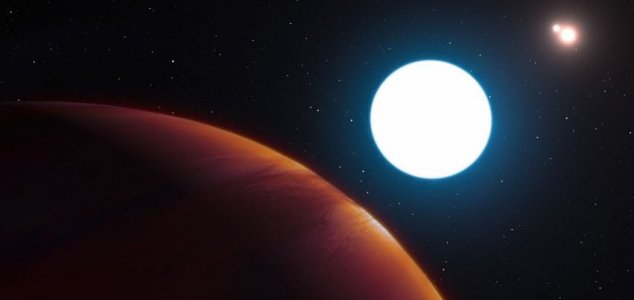Space & Astronomy
July 8, 2016 · 10 comments
10 comments

This distant world sees numerous sunrises and sunsets. Image Credit: ESO / L. Calcada
The planet itself orbits the largest of the three stars while its two smaller neighbors ensure a unique array of sunrises and sunsets as well as individual seasons lasting for hundreds of years.
"For about half of the planet's orbit, which lasts 550 Earth-years, three stars are visible in the sky, the fainter two always much closer together, and changing in apparent separation from the brightest star throughout the year," said PhD student Kevin Wagner.
"For much of the planet's year the stars appear close together, giving it a familiar night-side and day-side with a unique triple-sunset and sunrise each day."
"As the planet orbits and the stars grow further apart each day, they reach a point where the setting of one coincides with the rising of the other -- at which point the planet is in near-constant daytime for about one-quarter of its orbit, or roughly 140 Earth-years."
Source: CNET.com | Comments (10)
Astronomers find distant planet with 3 suns
By T.K. RandallJuly 8, 2016 ·
 10 comments
10 comments
This distant world sees numerous sunrises and sunsets. Image Credit: ESO / L. Calcada
The newly discovered exoplanet experiences days lasting up to 140 Earth-years thanks to its trio of suns.
Known as HD 131399Ab, this distant gas giant can be found in the constellation Centaurus and is situated within an unusual three-star system approximately 340 light years from the Earth.The planet itself orbits the largest of the three stars while its two smaller neighbors ensure a unique array of sunrises and sunsets as well as individual seasons lasting for hundreds of years.
"For much of the planet's year the stars appear close together, giving it a familiar night-side and day-side with a unique triple-sunset and sunrise each day."
"As the planet orbits and the stars grow further apart each day, they reach a point where the setting of one coincides with the rising of the other -- at which point the planet is in near-constant daytime for about one-quarter of its orbit, or roughly 140 Earth-years."
Source: CNET.com | Comments (10)

The Unexplained Mysteries
Book of Weird News
AVAILABLE NOW
Take a walk on the weird side with this compilation of some of the weirdest stories ever to grace the pages of a newspaper.
Click here to learn more

Support us on Patreon
BONUS CONTENTFor less than the cost of a cup of coffee, you can gain access to a wide range of exclusive perks including our popular 'Lost Ghost Stories' series.
Click here to learn more
United States and the Americas
Ancient Mysteries and Alternative History
Modern Mysteries, New Age and Prophecies
Israel, Palestine and the Middle-East
Total Posts: 7,768,289 Topics: 325,021 Members: 203,765
Not a member yet ? Click here to join - registration is free and only takes a moment!
Not a member yet ? Click here to join - registration is free and only takes a moment!


































Please Login or Register to post a comment.